Hello world!
Welcome to WordPress Sites. This is your first post. Edit or delete it, then start blogging!

Welcome to WordPress Sites. This is your first post. Edit or delete it, then start blogging!
Buying or selling a home rarely happens overnight, and it's not uncommon for buyers or sellers to interface or even work with multiple agents. Best-case scenario, the right agent shows their face early, and the relationship (and transaction) is a huge success.
But somewhere along the way, you may find that your relationship with your real estate agent just isn't working anymore. Maybe the agent is moving faster than you'd like. Or they're not as available as you need them to be. Maybe they just don't get you.
So what do you do? Is it OK to break up with your real estate agent? And if so, how do you gracefully end it?
The answer depends on whether you're working with an agent as a buyer or a seller.
Real estate agents earn their commissions from sellers, and the money is split between the sellers’ and buyers’ agents. As a general rule, buyers won't be asked to enter into a contractual or financial agreement with a real estate agent.
Instead, a buyer makes a (sometimes nonverbal) handshake agreement with the real estate agent. You're basically agreeing to exclusively rely upon that agent. And that's fair.
Agents often work hard and spend a lot of time engaging with buyers, watching the market, writing contracts, showing properties, reviewing disclosures and so on. Imagine how they'd feel after spending months working with a client only to be informed that another agent found them the home they want?
Before you shake hands, do your homework. Ask friends for references, and check out online agent reviews.
Going to open houses is a good way to meet and interview agents who work where you want to buy. Don’t jump in with the first agent you meet. Like any relationship, start slow and feel it out. It’s harder to break up with your agent if you’re deeply engaged.
If you're not quite ready to be tied down, it's better not to engage an agent until you are ready. Early on, a good real estate agent should read your situation well and provide the appropriate amount of attention as needed. They'll act as a resource and be available when you need them. Once the search kicks into high gear, agents and buyers will spend lots of time together and communicate 24/7.
If you do find that a relationship isn’t working, be honest and upfront before more time passes. Offer the agent constructive feedback about why it's not working for you.
Since the seller pays the real estate agent's commission, the brokerage requires the seller to sign a listing agreement upfront. During the listing period, you're contractually obligated to work exclusively with the agent and brokerage firm, specifically on the sale of your home.
In fact, even if you find a buyer on your own (such as a friend), the listing agent or brokerage firm is still due their commission.
Just as a buyer must do their homework, it's even more important for a seller to do their research, given the commitment. Most listing agreements state that if the listing agent brings an offer at the listing price and the seller doesn't accept it, the agent is still due a commission. This scenario happens sometimes when the listing agent and seller aren't getting along.
In most situations, if the listing agent isn't doing a good job but there's still time left on the agreement, you should simply tell them it's not working out. A good, fair and honest agent will apologize for not meeting your expectations and will agree to release you from the agreement ahead of schedule. But that's not always the case, and sellers typically respond by no longer agreeing to open houses or considering offers from the agent.
Sometimes an agent wants to break up with the seller. Maybe the seller insists on keeping the price of the home too high or isn't cooperating to accommodate showings. The agent simply feels they can't be successful with the seller, no matter how much time they put into the job.
If you're a seller whose agent wants out of the agreement because you aren't taking the necessary steps to sell your home, it's best to let them go - and decide if you're really ready to sell or not.
Related:
Note: The views and opinions expressed in this article are those of the author and do not necessarily reflect the opinion or position of Zillow.
Originally published September 2016.
We all love a house-flipping reality show - we shout our opinions and weep when we see the final reveal. It’s an innate human instinct to want to make things better. And when it comes to selling your own home, it’s often a good instinct to follow.
But while it may be OK to max out the budget on a reality TV show, pulling out all the stops in your own home renovation might not be the best choice. Depending on the real estate market, your neighborhood and what buyers are looking for, you may need to do less - or more - than you think.
Before you demolish all the walls, take these four considerations into account.
Does your local market favor buyers or sellers? You can tell the difference by looking at trends on Zillow, talking to a real estate agent or checking out nearby neighborhoods.
If a lot of nice for-sale homes in your area haven’t sold, it’s likely a buyers market. This means that shoppers have many homes to choose from, so the ones with the nicest updates, lowest prices and better neighborhoods will go first, leaving a lot of homes sitting idle on the market.
If homes are selling right and left, then it’s a sellers market. In this case, there aren’t as many homes for buyers to choose from, so sellers can often get above asking price as a result of bidding wars.
If you’re thinking about selling your home, understanding what the market is doing will help you determine how much you need to upgrade your home.
If it’s a buyers market, you’ll likely need to do more to your home to stand out. The average garage door replacement costs around $1,600, but if it makes your home stand out and sell faster, it may be a good move.
If it’s a sellers market, you can get away with upgrading less, since homeowners will be competing for your home regardless of how tricked out it is. Spend your money wisely on things like new counters or fixtures, and spruce up the rest with a fresh coat of paint and some elbow grease.
The next important factor is your neighborhood, because you don’t want to price yourself out of it. Do you live in a new development? Or an older one where the homes are 40, 50 or 60 years old? Do you have a homeowners association that will limit what you can do? Or can you renovate at will?
In older neighborhoods, you don’t want to renovate your house so much that it looks out of place or becomes a target for theft. You want to find a nice balance.
If most homes in your area have dated finishes, focus on a few crucial updates that’ll help your house stand out and stay within your neighborhood’s average pricing. People are less willing to buy a $475,000 house in a neighborhood where homes don’t usually sell for more than $300,000.
A good rule of thumb: Don’t raise your home’s value any higher than 10 percent of the average cost of homes in your neighborhood.
However, if you live in a nicer area and your house is the shabbiest on the block, you’ll want to spend a little more to keep up. Take a look at homes in your neighborhood that have sold in the last 90 days (you can find this right here on Zillow). Emulate the finishes those homes have while remaining within your budget.
Give your home the features buyers look for most. Many homeowners look for updated kitchens, master bedrooms and bathrooms. These three spaces alone can sell your home, so consider investing extra money in these areas.
If you have additional funds, consider replacing flooring or upgrading small things like lighting, fixtures and doorknobs.
Use your budget wisely, and consider going the DIY route - some projects can recoup a large part of your investment! If brand-new kitchen cabinets are out of your budget - or if they’d price you out of your current neighborhood - consider painting your current ones.
Of course, watch for sales or deals on things you can use in your renovations. Regardless of how old or new your neighborhood is, choose timeless styles and colors that will appeal to a wide range of home buyers.
If you do your market research and follow the trends, you’ll end up with a beautifully renovated home that will appeal to a large range of buyers.
Related
Originally published April 25, 2016.
Welcome to WordPress Sites. This is your first post. Edit or delete it, then start blogging!
When was the last time your home workspace or study station inspired you? For most people, the answer is, "Not recently."
Whether you’re prepping an area for your work-from-home days or setting up a spot for young scholars to study , you can kick inspiration into high gear with home office solutions that will get your creative juices flowing again.
It's no secret that sunshine does the body good. Fix up a space near the window so you can soak up plenty of vitamin D while pumping out price lists or writing that term paper.
Greenery looks great near a bright area, so a potted plant or two might help naturally bring your space to life.
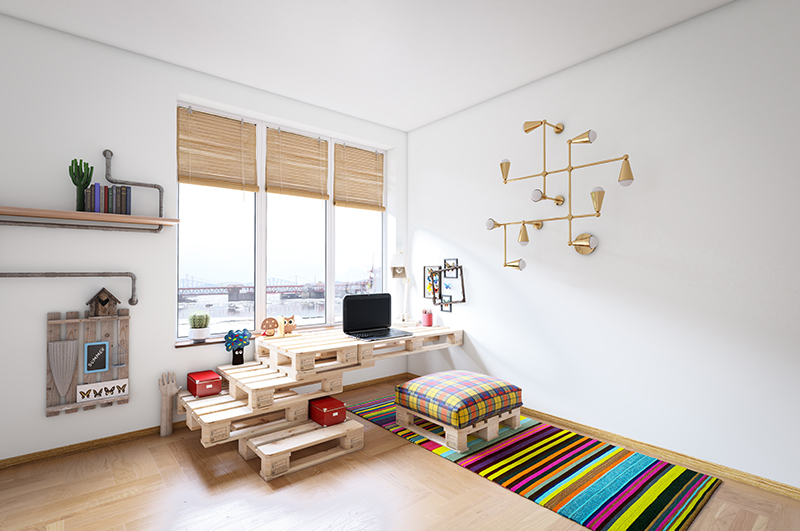
The age of DIY is upon us. Embrace the casual-cool vibes and create your very own home desk area.
Need a semipermanent to-do list? Try using chalkboard paint to make yourself a giant notepad on a nearby cabinet or a framed chalkboard. Tired of the overdone corkboard for your sticky notes? Framed chicken wire with clothespins makes a more shabby-chic memo board.
The possibilities really are endless for this type of style. Just don't let your DIYing get in the way of the tasks you originally sat down to do!
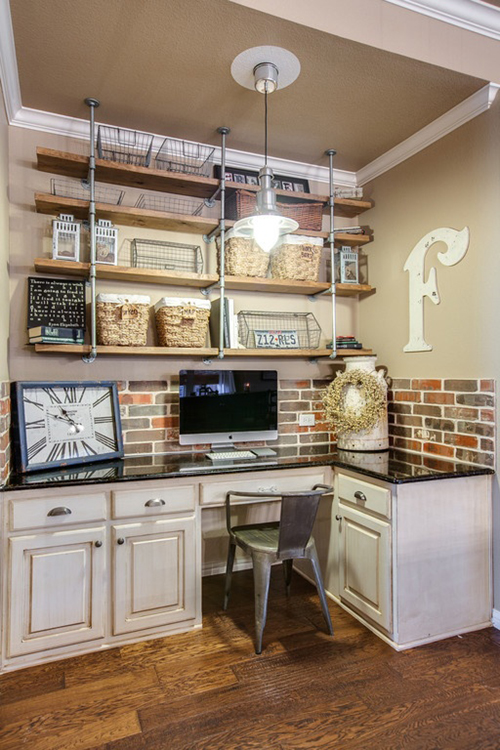
For those less focus-intensive projects, investigate a collaborative workstation with several small spaces or a giant community table. This type of work environment has been popular among small companies and creative agencies for the purpose of bouncing around ideas.
If you still want your own personal space, put a divider between you and the other desks for some extra privacy, and take it down when it's time to meet and discuss. You know what they say: Teamwork makes the dream work.
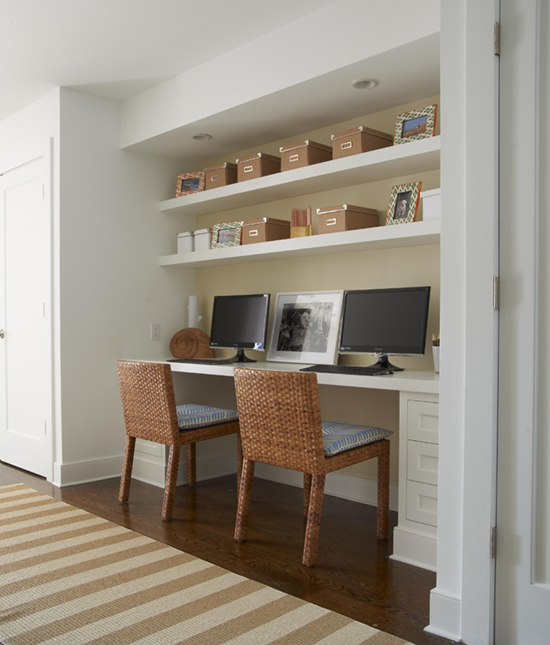
While many of us would like to think we have complete control of our habit of logging onto Facebook or checking what else our calendar has in store for us, most of us really don't. And the greatest enabler of this sidetracked behavior is a cluttered workspace.
Set the stage for a clean slate with a bright white desk and matching chair, a simple light fixture and an inspiring element. Keeping your workstation simple and clutter-free ensures you have a productive day - even if your homework is less than exhilarating.
Whether you're up all night cramming for exams or prepping for a work presentation due first thing in the morning, you'll feel more focused and productive by incorporating any of these tips into your workstation.
Related:
Originally published September 7, 2016.
This project will help you organize your garage and become the MVP of DIY projects. With all your sporting gear in the same place, you’ll always be prepared when someone yells, "Where’s my basketball?” (Or volleyball, hockey stick, tennis racket, etc.)
See how it’s done, then follow the step-by-step instructions to build one of your own.
Choose a bookcase with at least three wide shelves so you can store gear in a variety of sizes.
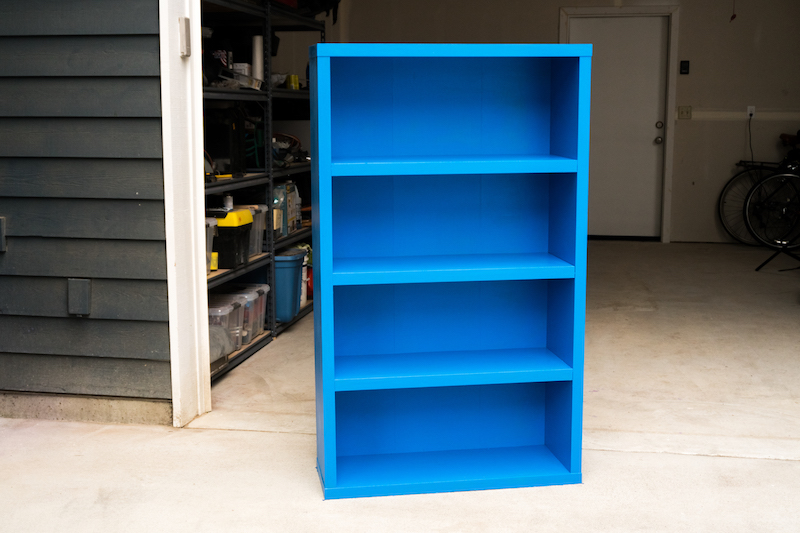
Attach locking wheels to the bottom of the bookcase so you can easily move it around the mudroom or the garage.
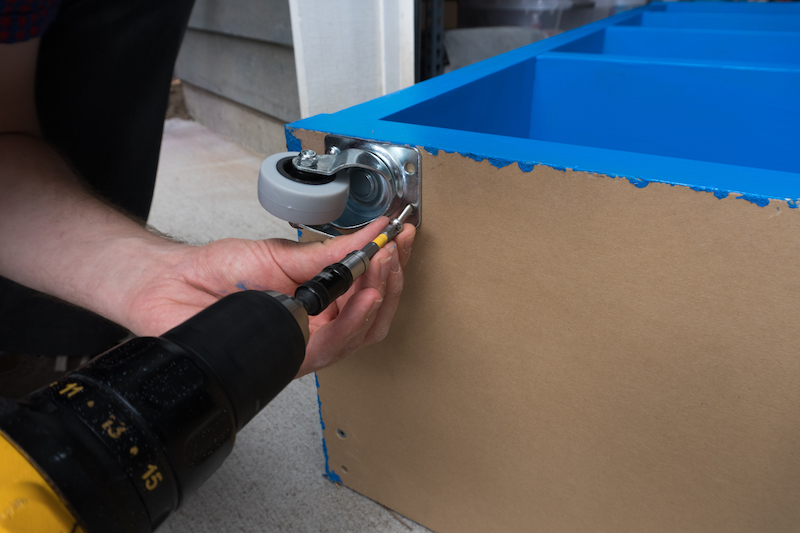
Drill evenly spaced holes (about four or five, depending on the width of the bookcase) along the top surface of one of the shelves. Keep the holes fairly close to the edge - about one-half inch away or less.
On the underside of the shelf below, drill holes to match up exactly with the holes on the shelf above.
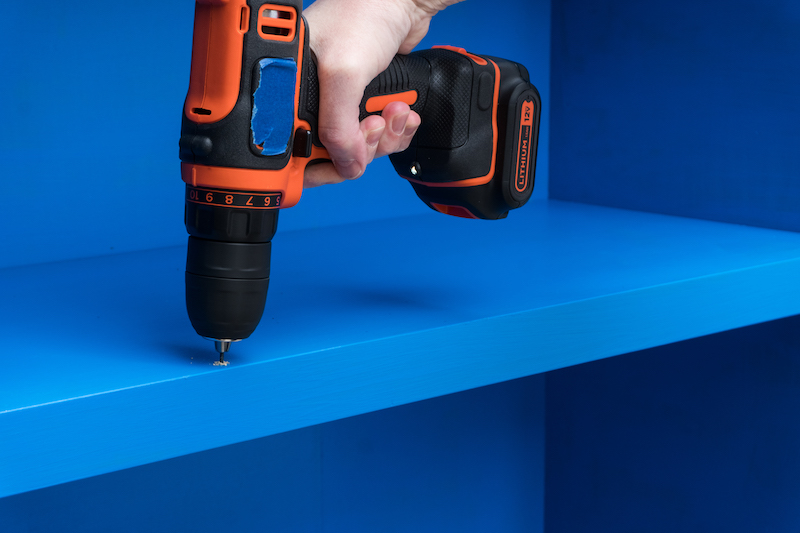
Place the bungee cord hooks in the drilled holes, and arrange the cords vertically so they create a net. You want the cords to be pretty taut, so get the right size for your bookcase.
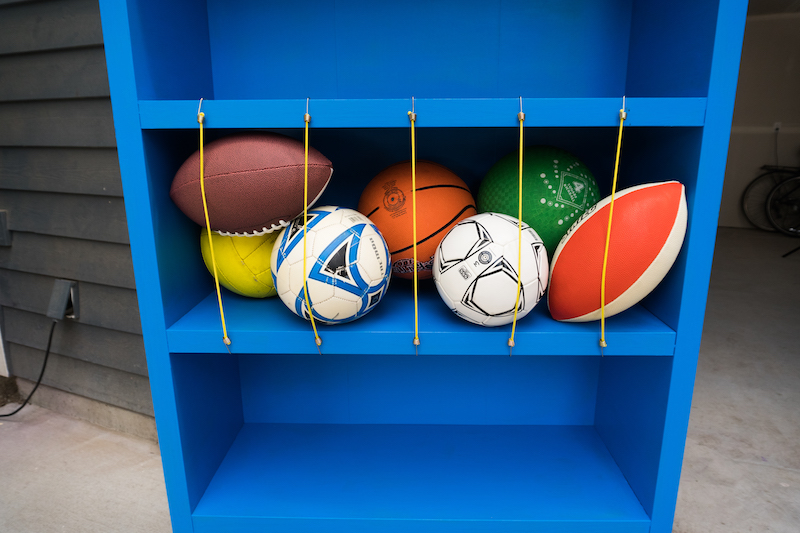
Frame the sides of your bookcase with 1-by-2-inch boards to support peg boards that have been cut to size. Secure the peg boards with a few nails on the top and bottom.
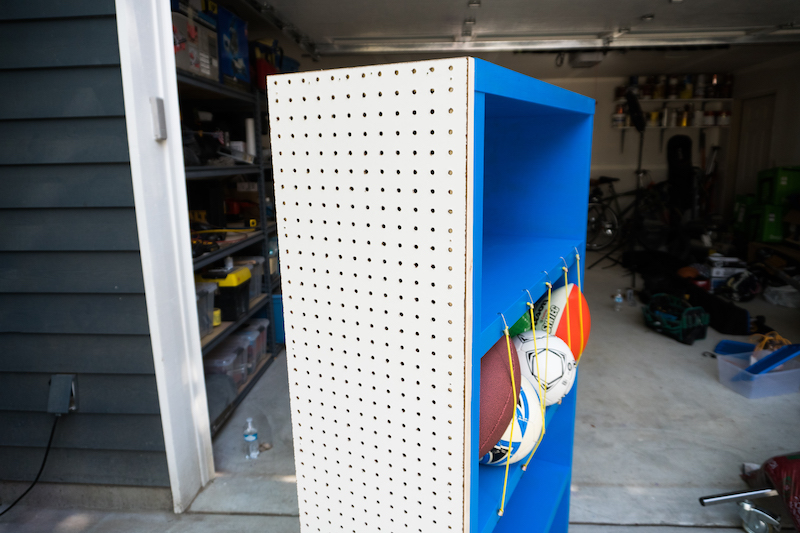
Place hooks and holders on the peg board so you can hang your tennis rackets, baseball gloves, jerseys, helmets and more.
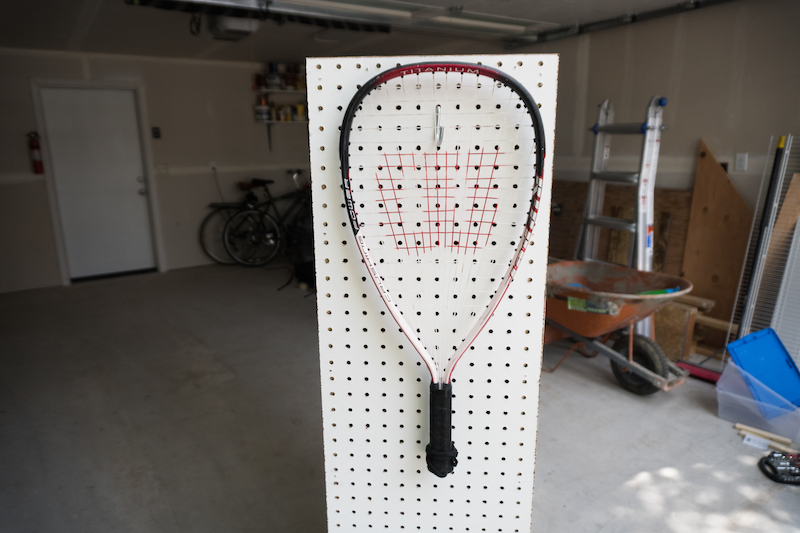
Grab your gear and organize the bins however you see fit. Now all you have to worry about is scoring the winning goal.
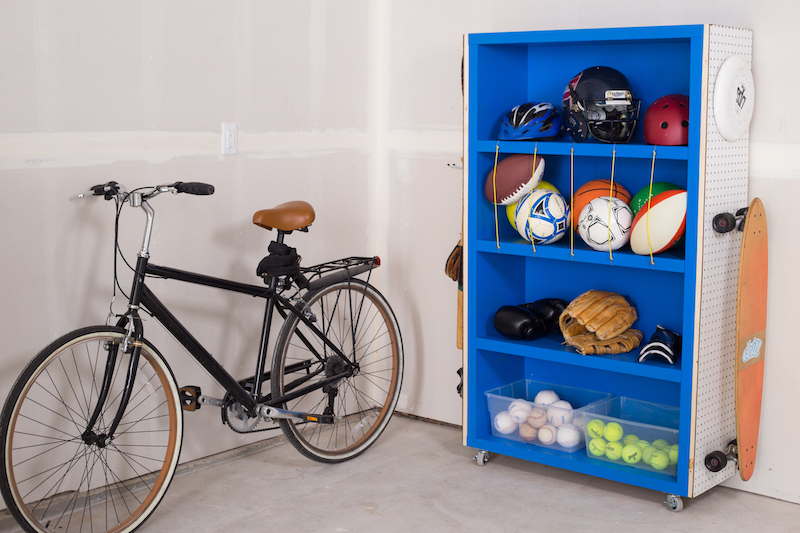
Related:
Although I have always been organized, there were two significant moments in my life that taught me how to manage clutter.
The first was when I returned from a backpacking trip around the world. Having visited homes in many developing nations, I no longer wanted to have such excess in my own home. My possessions were organized, but I had too many of them for my taste.
After I unpacked from my journey, I began a thorough review of my stuff. I started upstairs, removing unnecessary items floor by floor. By the time I reached the basement, I had enough stuff to set up a second apartment.
My second decluttering lesson was right after my divorce. Just months after the split, I was facing bankruptcy. I began my climb out of sudden and severe financial debt while simultaneously making a name for myself in the organizing industry. I hired a top-tier PR agent, but I knew I had to come up with some big bucks to cover his fee and all the expenses that go along with creating a brand. I decided to sell my home and everything I owned to make it happen.
As I sorted my belongings for a second time, I created the ranking system below to help me decide what to keep and what to toss. It worked beautifully for me, and I think it can work for you too.
5 - Important items whose place in your home is non-negotiable. For me, this included my green-stained Depression glass, photos, business files, office equipment and car.
4 - Items that are difficult to replace and items you use every day. This pile included most of my clothes, some furniture, a favorite sheet set, towels and jewelry.
3 - Items you use occasionally but haven’t used within the last six months.
2 - Items you rarely use but feel hesitant to toss.
1 - Items you never use, like seasonal items, specialized tools or kitchen gadgets. I got rid of stationery, extra wrapping paper, old boxes and my printer.
You know what I found as I used the clutter scale? There were rarely items that rated a 2 or 3. And once I established some criteria, I sorted and purged the 2s and 3s like never before. As you sort your less important items, ask yourself the following questions:
The clutter scale is a great way to get back in touch with your priorities. My priority at the time was starting my business, so I kept the bigger goal in sight and let go of anything that didn’t support it.
What I didn't know then was that I was already practicing what I was going to preach in my business. I learned to organize my life and stuff based on my values. I chose to collect experiences - not things.
As you declutter and rank your possessions, don’t forget to take a few minutes to think about your goals and values. You’ll find your home to be much more intentional and peaceful if you do!
Related:
Welcome to WordPress Sites. This is your first post. Edit or delete it, then start blogging!
Most homeowners have that one thing about their home that they wish were different.
For some, the home’s fatal flaw exists outside the four walls. Maybe the house backs up to a creek that floods whenever it rains, resulting in a squishy backyard and mosquitoes. Or perhaps the home is located on a busy street that generates too much traffic noise. It could just be that the house is too far from the homeowner’s job, and the long commute has gotten old.
If you’re feeling discontent with your home, you may be thinking about renovating … or getting out entirely. But before you knock down walls or put your home on the market, check out our quiz - it could help you think differently about your situation.
Related:
A polished home exterior creates an inviting experience for visitors or passersby, which is especially important if your home is on the market.
Check out our tips to get the most curb appeal for the lowest cost - while turning your neighbors' heads and getting prospective buyers to your door.
The easiest way to enhance curb appeal is dedicating a weekend to deep cleaning your home’s exterior.
Sure, you'll want to trim bushes, sweep and mow your lawn, but there's more to curb appeal than keeping a tidy front yard. Turn the nozzle on your garden hose to the strongest setting and clean off your driveway, sidewalk, windows and fence.
If dirt and grime are caked on your home's exterior, you can rent a powerwasher for around $50 to $75 a day. Just avoid areas with caulking, like windows and doors, because you can strip some of the sealing. And as tempting as it may be to powerwash your roof, don’t do it - you may damage the shingles’ coating.
When it comes to your windows, spraying them with a garden hose isn't enough. For maximum sparkle, clean your windows outside and inside. Instead of relying on a glass cleaner, try a mix of detergent diluted in warm water.
Shutters are an easy way to accentuate the size of your windows. They make your windows look larger and add visual interest by disrupting a bland exterior wall. For maximum curb appeal, choose a shutter color that contrasts with your home’s color to make it pop.
Paint is a quick and easy curb appeal booster. Instead of painting the entire exterior of your home, focus on the trim, door and shutters.
You can typically find a gallon of exterior paint for $20 to $30. But before you decide on a color, consider home exterior color trends, along with your home's natural style.
If you don’t love your front door, you don't need to dish out loads of money to replace it. Think beyond paint - consider adding molding, which offers a decorative frame for your door that welcomes visitors.
You can also add metal house numbers, which you can find for as low as $5 a number. And if seasonally appropriate, consider adding a wreath to your door as a bonus.
If you'd rather not add house numbers to your freshly painted door, here are some alternative DIY ideas:
Replacing your exterior light fixtures is another curb appeal must. You can usually find outdoor sconces for around $20 at home centers. Just make sure your new light fixtures have the same mounting system. And if you want to save on lighting, a fresh finish can do wonders. Try spray-painting them - a can of spray paint costs around $10.
Just as you would aim to simplify the interior of your home so shoppers can envision themselves living there, the exterior of your home should be neutral and welcoming too.
Put your pink flamingo and wind chime collection into storage, and focus on porch decor that offers pops of color and character. You can find brightly colored outdoor chairs or throw pillows for $20 to $30 each.
These low-budget fixes make a big impact, so don’t forget the little details!
Related: